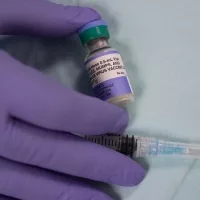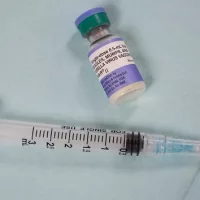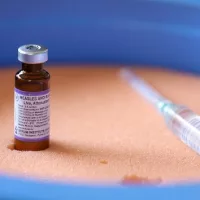
(NEW YORK) — Health officials have warned since the beginning of the COVID-19 vaccine rollout that areas with lower inoculation rates are at greater risk of higher cases, hospitalizations and deaths.
In fact, studies have shown areas with low vaccination rates had as many as 2.4 more new COVID-19 infections per 100,000 people compared to areas with high vaccination rates.
But states — and counties — with little vaccine uptake are not just facing the cost of more severe complications from the virus.
There’s also the cost to the healthcare system with staff needing to call out if they get infected and not able to serve other patients due to a surge of COVID-19-related admissions.
Families living in low vaccinated areas may also suffer a cost. This could mean adults have to miss work, and potentially lose wages, because they or their children test positive for COVID. Children who also have to miss school can fall behind on their lessons.
“I think most people want to make an informed decision [about vaccination] and they have a hard time identifying the information that describes the real situation,” Dr. Jennifer Dillaha, the Arkansas Department of Health’s director for immunizations, told ABC News. “I know it’s possible for people to downplay the seriousness of the illness that they or their family members or their community could experience.”
The strain on the healthcare system
In the U.S., 67.2% of the population is fully vaccinated as of Friday, according to the Centers for Disease Control and Prevention. But the rates between states vary starkly.
Some states have broken the 80% mark. Others have barely hit 55%, data shows.
As of Friday, in Arkansas, only 55.3% of residents are fully vaccinated, according to CDC data. Dillaha said low rates put a strain on hospitals, especially during surges.
“We did see that with both the delta and the omicron surges that we had in our state, the hospitals had to take steps to increase staffing so they could take care of more people who needed hospitalization,” she said. “And it made it difficult for people who needed hospitalization, for other reasons that were not related to COVID, to get a hospital bed.”
A similar situation existed in Alabama, where only 51.9% of the population is fully vaccinated, as of Friday.
“What we saw in our hospitals is an inability to deliver routine care,” Dr. Wes Stubblefield, district medical officer for the Alabama Department of Public Health, told ABC News. “During the height of some of these pandemic peaks, we saw hospitals that were closing elective orthopedic, outpatient surgeries, elective screening procedures, other things like that, that just couldn’t be done because of the sheer volume of patients that were there.”
Health officials say patients missing preventive care visits, general medical appointments, elective surgeries, or other care could increase the risk of an illness worsening or of death from conditions that were otherwise preventable or treatable.
The CDC estimates since the pandemic began there have been 1.1 million excess deaths, or deaths that exceed the numbers of people expected to die over the same period.
Additionally, hospital costs increased because administrators had to pay their staff higher wages, according to the health departments.
Because of staffing shortages — particularly of nurses — whether because there were not enough nurses to treat the number of COVID-19 hospitalized patients or because nurses fell ill themselves and there were not enough to cover shifts, many hospitals relied on traveling nurses.
Dillaha said that because states were competing for traveling nurses, Arkansas hospitals were offering higher wages to incentivize them to work there. She said this created a disparity between the wages of traveling nurses and the full-time staff nurses that had to be addressed.
“The hospitals had to address that by increasing the amount they paid for people who did not travel in order to encourage them to stay on the job,” she said.
Stubblefield said Alabama hospitals that had trouble paying staff competitive wages after paying high wages for nursing staff saw many people resign from their jobs.
“Having to pay very high rates for temporary nursing staff, we’ve seen turnover in the hospitals,” he said.
The cost to families
Doctors also stressed that families living in areas with low vaccination rates can suffer a cost — financially and emotionally.
Adults who contract the virus are forced to miss work, which can result in lost wages for those who are paid hourly and are not salaried.
“Where I live, we have a fair number of jobs where they really don’t have a lot of capacity to miss work,” Stubblefield said. “These jobs are very hard to come by. They pay relatively well for that kind of a job, but then they don’t get a lot of time off and getting sick can be very difficult for them.”
If they identify as one of the one in five Americans who develop long COVID, which is when symptoms last more than four weeks after recovering, that can also result in lost wages from missing time off work.
“If you have persistent symptoms over a long period of time, which makes it difficult or impossible for them to go back to work or go back to school, that is a hardship for families as well,” Dillaha said.
Parents may also be forced to miss work if they have a child who gets sick and can’t attend school or daycare, or if their classroom or school closes due to an outbreak and they must switch to remote learning.
To drive up vaccination rates — and prevent as many days lost of school and work as possible — Stubblefield said it’s important to try to have individual conversations with those who are vaccine hesitant, something he did as a pediatrician for 14 years before joining the health department less than a year ago.
“There’s a lot to be said about not trying to get into a long debate,” he said. “The main thing is we would talk about our own personal experience, how we would do this for our own families, and we wouldn’t do anything, or suggest or recommend anything, that we wouldn’t recommend for ourselves or our own families.”
He continued, “Hopefully they would have a relationship with us so that we could have a conversation, a civil conversation, and we could come to an agreement and whether that agreement is to reconsider [vaccination] at the next visit or then to make that decision [to vaccinate] and move forward.”
Copyright © 2022, ABC Audio. All rights reserved.














